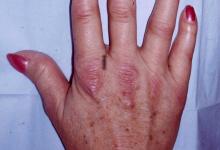SARD-ILD and serious infection risk: The elephant in the room Save

Interstitial lung disease (ILD) remains one of the largest unmet clinical needs across many systemic autoimmune rheumatic diseases (SARD). ILD is highly prevalent across systemic sclerosis, mixed connective tissue disease, idiopathic inflammatory myopathy, rheumatoid arthritis (RA), and Sjögren disease1. Mortality is elevated for people with ILD among all of these individual SARDs1. In RA, mortality remains quite elevated for those ILD despite expanded treatment options in the biologic era2. Antifibrotics slow forced vital capacity decline but have not seemed to have made a major impact on mortality and other outcomes3.
Clinicians are already keenly aware of the complexity of patients with SARD-ILD. There are often multiple organs involved, each of which may necessitate their own tailored treatment. This means many people may need to be on combination immunosuppressants. SARD-ILD may often involve high-dose glucocorticoids, imparting all the well-known toxicities. Currently approved antifibrotics are typically reserved for progressive patients and have relatively poor tolerability. These patients are very often older, meaning many have challenges related to multiple comorbidities, frailty, polypharmacy, and financial/access issues.
The “elephant in the room” for all these issues: serious infection.
Serious infection looms over patients with SARD-ILD for several reasons. First, these patients have baseline lung damage and poor pulmonary reserve. This means that would have been a “minor” infection for most could land patients with SARD-ILD in the hospital—or even be lethal. Indeed, our group recently investigated the association of ILD with mortality and serious infection among people with RA4. People with RA-ILD had nearly 3-fold increased mortality compared to RA-no ILD4. This risk was particularly elevated for people with RA and fibrotic ILD such as usual interstitial pneumonia4. RA-ILD was associated 4-fold higher infection-related mortality compared to RA without ILD4. This finding was adjusted for RA treatments including glucocorticoids as well as serostatus, demographics, and comorbidities4. RA-ILD patients had particularly elevated risk for viral infections, particularly COVID-194, consistent with our prior study5.
We recently performed a follow-up study by investigating RA-ILD and serious infection (i.e., hospitalized)6, rather than only mortality. In that study, RA-ILD was associated with 79% higher risk of serious infection6. As expected, pulmonary infections were the most common anatomic site6. Interestingly, RA-ILD had higher risk of other types of infection that included skin and soft tissue, urinary tract, and ear, nose, and throat infections6. This may have been due to heavier immunosuppression in these patients. This paper also provided very granular data about pathogen types. RA-ILD had higher risk for viral, bacterial, fungal, and mycobacterial serious infections6. The number and diversity of specific pathogens higher in RA-ILD is daunting. RA-ILD was associated with higher risk of influenza, herpes simplex virus, respiratory syncytial virus, cytomegalovirus, parainfluenza,Staphylococcus, Pseudomonas,E. coli,Haemophilus influenzae, syphilis, non-tuberculous mycobacteria,Candida,Aspergillus, and Pneumocystis6.
The reasons for this serious infection risk in SARD-ILD are likely myriad. First, they have baseline lung damage and poor pulmonary reserve with frailty. This means an infection can tip them over the scales to need hospitalization—and can even be lethal. As already discussed, these patients are likely more heavily immunosuppressed and to be on combination therapy. They may also be more likely to be on “heavier” immunosuppressants such as rituximab or mycophenolate, recommended for SARD-ILD by both the ACR7 and EULAR8. These medications also happen to be the ones most associated with inadequate vaccine response. They may also be on higher doses of glucocorticoids, and for longer durations. The complexity of these patients may mean that patients are less likely to start DMARDs. This can be a reluctance of patients to accept recommendations, or clinical inertia from clinicians to not start or intensify DMARD treatment. Paradoxically, this may result in more glucocorticoid use, and higher infection risk.
Where do we go from here?
Ideally, we would find new medications that adequately treat SARD-ILD and other SARD manifestations without raising infection risk or impairing vaccine response. This does not seem to exist yet, at least for most patients. In the meantime, only a few of these pathogens (SARS-CoV-2, influenza, RSV, Pneumococcus) have available vaccines, and these should be pursued, ideally prior to potent immunosuppression. We should remember to prophylax these patients for Pneumocystis while on higher doses of glucocorticoids. Research should pursue whether other antimicrobial prophylaxis may have clinical utility in this population. We should have high clinical suspicion, particularly for pathogens that may be indolent or subclinical. Of course, once diagnosed, we should treat the underlying pathogen and consider brief interruption of immunosuppression. Lastly, it can be quite difficult to disentangle respiratory infection from underlying progression of SARD-ILD in this immunosuppressed and vulnerable patient population.
In conclusion, serious infection looms as the elephant in the room for people with SARD-ILD. This risk haunts every aspect of diagnosis, treatment, and monitoring. This is a major reason for poor outcomes. This is a major clinical need to find treatments that do not impart infection risk.
1. Joy GM, Arbiv OA, Wong CK, et al. Prevalence, imaging patterns and risk factors of interstitial lung disease in connective tissue disease: a systematic review and meta-analysis. Eur Respir Rev 2023; 32(167).
2. Saavedra AA, Mueller KT, Kowalski EN, et al. Treatment of rheumatoid arthritis-associated interstitial lung disease: An appraisal of the 2023 ACR/CHEST guideline. Curr Treatm Opt Rheumatol 2024; 10(4): 43-60.
3. Juge PA, Hayashi K, McDermott GC, et al. Effectiveness and tolerability of antifibrotics in rheumatoid arthritis-associated interstitial lung disease. Semin Arthritis Rheum 2024; 64: 152312.
4. Zhang Q, Qi Y, Wang X, et al. Risk of total and cause-specific mortality in patients with rheumatoid arthritis-associated interstitial lung disease or bronchiectasis. Rheumatology (Oxford) 2025.
5. Figueroa-Parra G, Gilbert EL, Valenzuela-Almada MO, et al. Risk of severe COVID-19 outcomes associated with rheumatoid arthritis and phenotypic subgroups: a retrospective, comparative, multicentre cohort study. Lancet Rheumatol 2022; 4(11): e765-e74.
6. Zhang Q, Qi Y, Wang X, et al. Risk of serious infection in patients with rheumatoid arthritis-associated interstitial lung disease or bronchiectasis: A comparative cohort study. Arthritis Rheumatol 2025.
7. Johnson SR, Bernstein EJ, Bolster MB, et al. 2023 American College of Rheumatology (ACR)/American College of Chest Physicians (CHEST) Guideline for the Treatment of Interstitial Lung Disease in People with Systemic Autoimmune Rheumatic Diseases. Arthritis Rheumatol 2024; 76(8): 1182-200.
8. Antoniou KM, Distler O, Gheorghiu AM, et al. ERS/EULAR clinical practice guidelines for connective tissue diseases associated interstitial lung disease. Ann Rheum Dis 2025.











If you are a health practitioner, you may Login/Register to comment.
Due to the nature of these comment forums, only health practitioners are allowed to comment at this time.